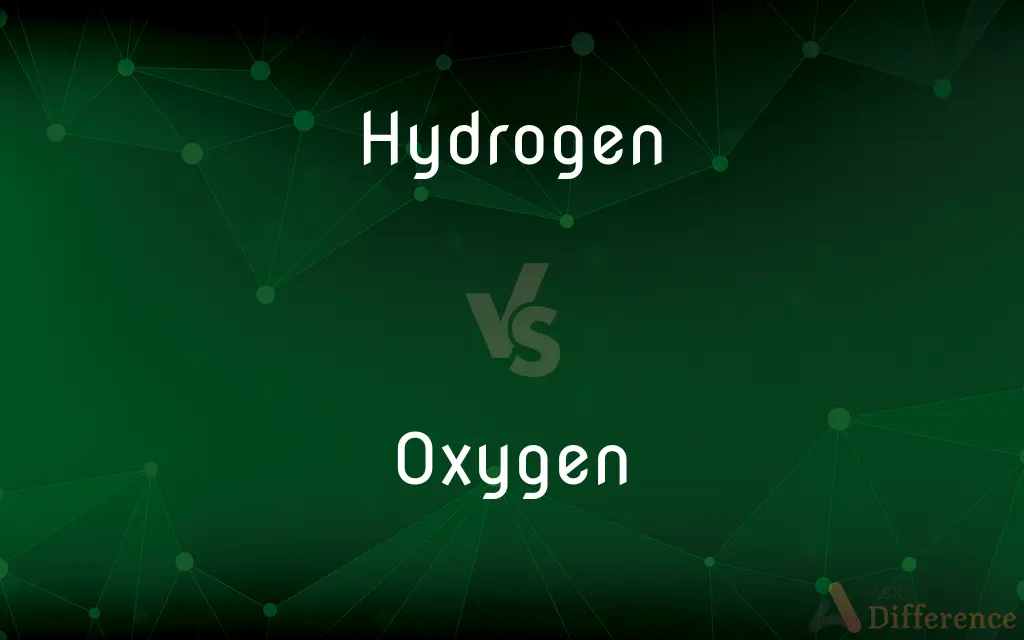Hydrogen vs. Oxygen — What's the Difference?
By Tayyaba Rehman — Published on August 27, 2023
Hydrogen is a colorless, odorless gas with atomic number 1; oxygen is a vital gas with atomic number 8 that supports combustion.

Difference Between Hydrogen and Oxygen
Table of Contents
ADVERTISEMENT
Key Differences
Hydrogen is the lightest element on the periodic table with an atomic number of 1, while oxygen has an atomic number of 8, making it denser and heavier.
Hydrogen is primarily found as a diatomic molecule (H2) in its natural state. In contrast, oxygen mostly exists as O2, which we breathe to sustain life.
When hydrogen combusts in the presence of oxygen, it produces water. This reaction is highly exothermic and forms the basis for hydrogen fuel cells.
Oxygen is vital for most forms of life, as it is essential for cellular respiration. Hydrogen, however, doesn't play a direct role in cellular respiration but is crucial in many biochemical reactions.
In terms of cosmic abundance, hydrogen is the most abundant element in the universe. Oxygen, although less abundant, is crucial for the formation of water and life on planets like Earth.
ADVERTISEMENT
Comparison Chart
Atomic Number
1
8
Abundance in Universe
Most abundant element
Third most abundant element
Molecular Form
H2 (Diatomic)
O2 (Diatomic)
Major Uses
Fuel, producing ammonia
Breathing, supports combustion
Relationship with Water
Forms water when combined with oxygen
Combines with hydrogen to form water
Compare with Definitions
Hydrogen
Hydrogen is the lightest and most abundant element in the universe.
The sun primarily consists of hydrogen.
Oxygen
Oxygen is a chemical element with the symbol O and atomic number 8.
Oxygen is crucial for the respiration of many organisms.
Hydrogen
Hydrogen has one proton and one electron.
Hydrogen's simplicity makes it unique among elements.
Oxygen
Oxygen supports combustion and is essential for fire.
Without oxygen, the campfire wouldn't burn.
Hydrogen
Hydrogen is a colorless, odorless gas under standard conditions.
When inhaled in pure form, hydrogen is not toxic.
Oxygen
Oxygen is a diatomic molecule, often represented as O2.
We breathe in O2 and exhale CO2.
Hydrogen
Hydrogen can be used as a clean fuel source.
Fuel cells utilize hydrogen to generate electricity.
Oxygen
A colourless, odourless reactive gas, the chemical element of atomic number 8 and the life-supporting component of the air.
An oxygen supply
If breathing stops, there is no oxygen getting to the brain and the cells begin to die
Hydrogen and carbon in the fuel combine with the oxygen in the air to form carbon dioxide and water
Hydrogen
Hydrogen bonds are weak attractions between molecules.
Water's unique properties arise from hydrogen bonding.
Oxygen
Oxygen constitutes about 21% of Earth's atmosphere.
Oxygen levels are crucial for sustaining life on Earth.
Hydrogen
A gaseous element, colorless, tasteless, and odorless, the lightest known substance, being fourteen and a half times lighter than air (hence its use in filling balloons), and over eleven thousand times lighter than water. It is very abundant, being an ingredient of water and of many other substances, especially those of animal or vegetable origin. It may by produced in many ways, but is chiefly obtained by the action of acids (as sulphuric) on metals, as zinc, iron, etc. It is very inflammable, and is an ingredient of coal gas and water gas. It is standard of chemical equivalents or combining weights, and also of valence, being the typical monad. Symbol H. Atomic weight 1.
Oxygen
The chemical element (symbol O) with an atomic number of 8 and relative atomic mass of 15.9994. It is a colorless and odorless gas. Category:en:Oxygen
Hydrogen
Molecular hydrogen (H2), a colourless, odourless and flammable gas at room temperature.
Oxygen
Molecular oxygen (O2), a colorless, odorless gas at room temperature, also called dioxygen.
Hydrogen
The lightest chemical element (symbol H), with an atomic number of 1 and atomic weight of 1.00794. Category:en:Hydrogen
Oxygen
(medicine) A mixture of oxygen and other gases, administered to a patient to help them breathe.
Hydrogen
An atom of the element.
Oxygen
Oxygen is necessary for aerobic respiration in cells.
Cells produce energy efficiently in the presence of oxygen.
Hydrogen
A sample of the element/molecule.
Oxygen
Oxygen is the chemical element with the symbol O and atomic number 8. It is a member of the chalcogen group in the periodic table, a highly reactive nonmetal, and an oxidizing agent that readily forms oxides with most elements as well as with other compounds.
Hydrogen
Hydrogen is the chemical element with the symbol H and atomic number 1. Hydrogen is the lightest element in the periodic table.
Oxygen
A nonmetallic element constituting 21 percent of the atmosphere by volume that occurs as a diatomic gas, O2, and in many compounds such as water and silica, and in iron ore. It combines with most elements, is essential for plant and animal respiration, and is required for nearly all combustion. Ozone, O3, is an allotrope of this element. Atomic number 8; atomic weight 15.9994; melting point -218.79°C; boiling point -182.9°C; gas density at 0°C 1.429 grams per liter; valence 2. See Periodic Table.
Hydrogen
A colorless, highly flammable element, that occurs as a diatomic molecule, H2, the lightest of all gases and the most abundant element in the universe, used in the production of synthetic ammonia and methanol, in petroleum refining, in the hydrogenation of organic materials, as a reducing atmosphere, in oxyhydrogen torches, in cryogenic research, and in rocket fuels. Atomic number 1; atomic weight 1.00794; melting point -259.1°C; boiling point -252.8°C; density at 0°C 0.08988 gram per liter; valence 1. See Periodic Table.
Oxygen
(countable) An atom of this element.
Hydrogen
A molecule of this molecular species
Oxygen
(figurative) A condition or environment in which something can thrive.
Silence is the oxygen of shame.
They hoped to starve the terrorists of the oxygen of publicity.
Hydrogen
A nonmetallic univalent element that is normally a colorless and odorless highly flammable diatomic gas; the simplest and lightest and most abundant element in the universe
Oxygen
A colorless, tasteless, odorless, gaseous element of atomic number 8, occurring in the free state in the atmosphere, of which it forms about 23 per cent by weight and about 21 per cent by volume, being slightly heavier than nitrogen. Symbol O. Atomic weight 15.9994.
Oxygen
Chlorine used in bleaching.
Oxygen
A nonmetallic bivalent element that is normally a colorless odorless tasteless nonflammable diatomic gas; constitutes 21 percent of the atmosphere by volume; the most abundant element in the earth's crust
Common Curiosities
What is hydrogen?
Hydrogen is a chemical element with the symbol H and atomic number 1. It's the lightest and most abundant chemical substance in the universe, primarily found in stars and gas giant planets.
4. What is oxygen?
Oxygen is a chemical element with the symbol O and atomic number 8. It's a member of the chalcogen group on the periodic table and is a highly reactive non-metal. It's essential for respiration in most life forms.
What is the main use of hydrogen?
Hydrogen is used in various applications, including the production of ammonia for fertilizers, refining petroleum, and as a fuel source in fuel cells. Additionally, it has potential as a clean energy carrier in the future.
5. Why is oxygen important for life?
Oxygen is vital for cellular respiration in many organisms. It allows cells to produce energy efficiently from nutrients. Without oxygen, most higher life forms, including humans, would not survive.
7. How is hydrogen different from oxygen?
Hydrogen and oxygen are distinct elements with different properties. Hydrogen has one proton and one electron, while oxygen has eight protons and eight electrons. While both are gases at room temperature, they have different reactivities, uses, and roles in nature.
8. Can hydrogen and oxygen be combined?
Yes, hydrogen and oxygen can be combined in a chemical reaction to produce water (H2O). This reaction is exothermic, meaning it releases energy in the form of heat.
Is hydrogen flammable?
Yes, hydrogen is highly flammable. When mixed with air, it can form explosive mixtures, which is why safety precautions are essential when handling or storing hydrogen.
10. How are hydrogen and oxygen commercially produced?
Hydrogen is primarily produced by steam reforming of natural gas, though there are other methods like electrolysis of water. Oxygen is commonly produced by the fractional distillation of liquefied air.
6. Can oxygen be dangerous?
In high concentrations, oxygen can be dangerous. It can support rapid combustion and increase the intensity of fires. Breathing pure oxygen at high pressures, such as in deep-sea diving, can lead to oxygen toxicity.
9. Is the air we breathe pure oxygen?
No, the air we breathe is primarily composed of nitrogen (about 78%) and oxygen (about 21%), with small amounts of other gases like carbon dioxide, argon, and trace amounts of various others.
Share Your Discovery

Previous Comparison
Comma vs. Period
Next Comparison
Deception vs. DeceitAuthor Spotlight
Written by
Tayyaba RehmanTayyaba Rehman is a distinguished writer, currently serving as a primary contributor to askdifference.com. As a researcher in semantics and etymology, Tayyaba's passion for the complexity of languages and their distinctions has found a perfect home on the platform. Tayyaba delves into the intricacies of language, distinguishing between commonly confused words and phrases, thereby providing clarity for readers worldwide.














































